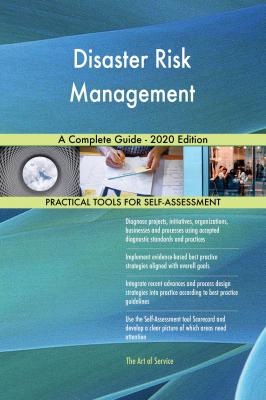Disaster Risk Management A Complete Guide - 2020 Edition. Gerardus Blokdyk
Читать онлайн.| Название | Disaster Risk Management A Complete Guide - 2020 Edition |
|---|---|
| Автор произведения | Gerardus Blokdyk |
| Жанр | Зарубежная деловая литература |
| Серия | |
| Издательство | Зарубежная деловая литература |
| Год выпуска | 0 |
| isbn | 9781867459279 |
123. Is the Disaster risk management scope complete and appropriately sized?
<--- Score
124. Are task requirements clearly defined?
<--- Score
125. Do you have a Disaster risk management success story or case study ready to tell and share?
<--- Score
126. Is there a clear Disaster risk management case definition?
<--- Score
127. Has a team charter been developed and communicated?
<--- Score
128. How are consistent Disaster risk management definitions important?
<--- Score
129. Are different versions of process maps needed to account for the different types of inputs?
<--- Score
130. What are the Disaster risk management use cases?
<--- Score
131. How do you catch Disaster risk management definition inconsistencies?
<--- Score
132. Is there regularly 100% attendance at the team meetings? If not, have appointed substitutes attended to preserve cross-functionality and full representation?
<--- Score
Add up total points for this section: _____ = Total points for this section
Divided by: ______ (number of statements answered) = ______ Average score for this section
Transfer your score to the Disaster risk management Index at the beginning of the Self-Assessment.
CRITERION #3: MEASURE:
INTENT: Gather the correct data. Measure the current performance and evolution of the situation.
In my belief, the answer to this question is clearly defined:
5 Strongly Agree
4 Agree
3 Neutral
2 Disagree
1 Strongly Disagree
1. Did you tackle the cause or the symptom?
<--- Score
2. What disadvantage does this cause for the user?
<--- Score
3. Are there measurements based on task performance?
<--- Score
4. What do people want to verify?
<--- Score
5. Will Disaster risk management have an impact on current business continuity, disaster recovery processes and/or infrastructure?
<--- Score
6. What causes extra work or rework?
<--- Score
7. Are indirect costs charged to the Disaster risk management program?
<--- Score
8. What are the uncertainties surrounding estimates of impact?
<--- Score
9. What do you measure and why?
<--- Score
10. What are your primary costs, revenues, assets?
<--- Score
11. How do you control the overall costs of your work processes?
<--- Score
12. What would it cost to replace your technology?
<--- Score
13. What measurements are possible, practicable and meaningful?
<--- Score
14. Where can you go to verify the info?
<--- Score
15. How can you manage cost down?
<--- Score
16. Where is it measured?
<--- Score
17. When are costs are incurred?
<--- Score
18. Is it possible to estimate the impact of unanticipated complexity such as wrong or failed assumptions, feedback, etcetera on proposed reforms?
<--- Score
19. What are you verifying?
<--- Score
20. How do you quantify and qualify impacts?
<--- Score
21. Do you verify that corrective actions were taken?
<--- Score
22. Have you made assumptions about the shape of the future, particularly its impact on your customers and competitors?
<--- Score
23. What does losing customers cost your organization?
<--- Score
24. How can a Disaster risk management test verify your ideas or assumptions?
<--- Score
25. How do you measure efficient delivery of Disaster risk management services?
<--- Score
26. What is the Disaster risk management business impact?
<--- Score
27. Do you aggressively reward and promote the people who have the biggest impact on creating excellent Disaster risk management services/products?
<--- Score
28. What are allowable costs?
<--- Score
29. How can you reduce the costs of obtaining inputs?
<--- Score
30. How do you verify performance?
<--- Score
31. How do you prevent mis-estimating cost?
<--- Score
32. What are the costs and benefits?
<--- Score
33. Do you have a flow diagram of what happens?
<--- Score
34. Why do you expend time and effort to implement measurement, for whom?
<--- Score
35. What could cause you to change course?
<--- Score
36. What would be a real cause for concern?
<--- Score
37. Are there any easy-to-implement alternatives to Disaster risk management? Sometimes other solutions are available that do not require the cost implications of a full-blown project?
<--- Score
38. Are you taking your company in the direction of better and revenue or cheaper and cost?
<--- Score
39. What causes innovation to fail or succeed in your organization?
<--- Score
40. Do you effectively measure and reward individual and team performance?
<--- Score
41. What causes investor action?
<--- Score
42. What are
